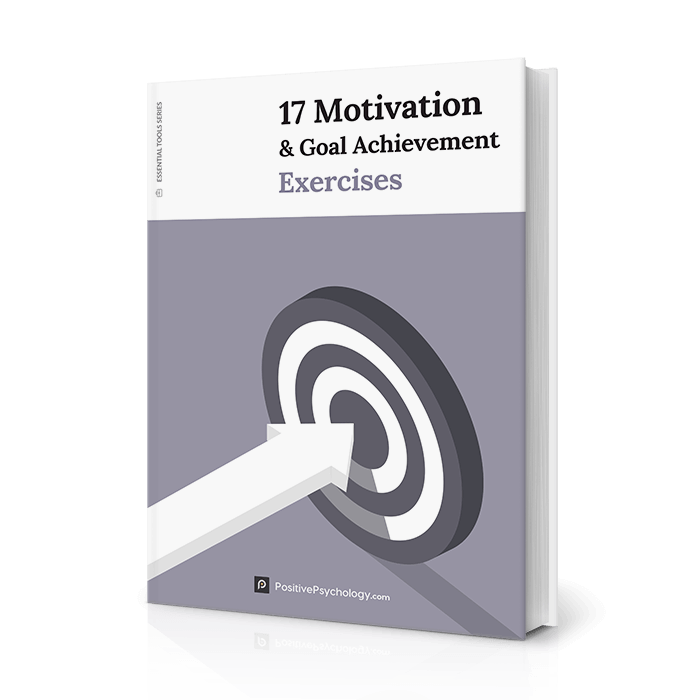

When individuals arrive for counseling, they typically seek change, clarity, advice, and help to overcome their difficulties.
Counseling is highly beneficial, with “far-reaching effects in life functioning” (Cochran & Cochran, 2015, p. 7).
While therapeutic relationships are vital to a positive outcome, so too are the selection and use of psychological interventions targeting the clients’ capability, opportunity, motivation, and behavior (Michie et al., 2014).
This article introduces some of the best interventions while identifying the situations where they are likely to create value for the client, helping their journey toward meaningful, value-driven goals.
Before you continue, we thought you might like to download our three Goal Achievement Exercises for free. These detailed, science-based exercises will help you or your clients create actionable goals and master techniques to create lasting behavior change.
“Changing ingrained behavior patterns can be challenging” and must avoid or at least reduce the risk of reverting (Michie et al., 2014, p. 11).
The American Psychological Association (n.d., para. 1) describes an intervention as “any action intended to interfere with and stop or modify a process, as in treatment undertaken to halt, manage, or alter the course of the pathological process of a disease or disorder.”
Interventions are intentional behaviors or “change strategies” introduced by the counselor to help clients implement problem management and move toward goals (Nelson-Jones, 2014):
Creating or choosing the most appropriate intervention requires a thorough assessment of the client’s behavioral targets, what is needed, and how best to achieve them (Michie et al., 2014).
The selection of the intervention is guided by the:
During counseling, various interventions are likely to be needed at different times. For that reason, counselors will require a broad range of techniques that fit the client’s needs, values, and culture (Corey, 2013).
In recent years, an increased focus has been on the use of evidence-based practice, where the choice and use of interventions is based on the best available research to make a difference in the lives of clients (Corey, 2013).

Various therapeutic interventions can be beneficial at different points in the treatment, depending on the client’s needs.
“Clients are hypothesis makers and testers” who have the reflective capacity to think about how they think (Nelson-Jones, 2014, p. 261).
Helping clients attend to their thoughts and learn how to instruct themselves more effectively can help them break repetitive patterns of insufficiently strong mind skills while positively influencing their feelings.
The following list includes some of the most popular interventions used in a variety of therapeutic settings (modified from Magyar-Moe et al., 2015; Sommers-Flanagan & Sommers-Flanagan, 2015; Cochran & Cochran, 2015; Corey, 2013):
Rigid, demanding thinking is identified by ‘musts,’ ‘oughts,’ and ‘shoulds’ and is usually unhelpful to the client.
I must do well in this test, or I am useless.
People must treat me in the way I want; otherwise, they are awful.
Clients can be helped to dispute such thinking using “reason, logic, and facts to support, negate or amend their rules” (Nelson-Jones, 2014, p. 265).
Such interventions include:
Our perceptions greatly influence how we think. Clients can benefit from recognizing they have choices in how they perceive things and avoiding jumping to conclusions.
This is not the end of the world.
I’ve done this before; I can do it well again.
One simple exercise to help clients see the strong relationship between visualizing and feeling involves asking clients to think of someone they love. Almost always, they form a mental image along with a host of feelings.
Visual relaxation is a powerful self-helping skill involving clients taking time out of their busy life to find calm through vividly picturing a real or imagined relaxing scene.
Clients’ explanatory styles (such as expecting to fail) can create self-fulfilling prophecies. Interventions can help by:
For example, the client can imagine rolling forward to a time when they are successful in a new role at work or a developing relationship.
Goals can motivate clients to improve performance and transition from where they are now to where they would like to be. However, it is essential to make sure they are realistic, or they risk causing undue pressure and compromising wellbeing.
The following interventions can help (Nelson-Jones, 2014):
Does the goal reflect your values?
Is the goal realistic and achievable?
Is the goal specific?
Is the goal measurable?
Does the goal have a timeframe?
Counseling can influence clients’ emotions and their physical reactions to emotions by helping them (Nelson-Jones, 2014):
The client may be asked to shift to the empty chair and play the other person’s part to explore conflict, interactions, and emotions more fully (Corey, 2013).

These detailed, science-based exercises will help you or your clients create actionable goals and master techniques for lasting behavior change.
Download PDF
By filling out your name and email address below.
“Counselors and counseling trainees make choices both concerning specific interventions and about interventions used in combination” (Nelson-Jones, 2014, p. 223).
Through early and continued engagement with the client throughout the counseling approach, the counselor and client set specific, measurable, and achievable goals and create a treatment plan with a defined intervention strategy (Dobson, 2010).
The treatment plan becomes a map, combining interventions to reach client goals and overcome problems – to get from where they are now to where they want to be. However, no plan should be too fixed or risk preventing the client’s progress in their ‘wished-for’ direction. Rather, it must be open for regular revisit and modification (Nelson-Jones, 2014).
Counseling and therapeutic treatment plans vary according to the approaches used and the client’s specific needs but should be strength-based and collaborative. Most treatment plans typically consider the following points (modified from GoodTherapy, 2019):
While a vital aspect of the counseling process is to ensure that treatment takes an appropriate direction for the client, it is also valuable and helpful for clients and insurance companies to understand likely timescales.

While there are many counseling strategies and interventions available, some have particular value in dealing with clients presenting specific (and combined) issues, including the following.
“Depression is one of the most common mental health disorders with a high burden of disease and the leading cause of years of life lost due to disability” (Hu et al., 2020, p. 1).
Anxiety can stop clients from living their lives fully and experiencing positive emotions. Many interventions can help, including:
Grief therapy helps clients accept reality, process the pain, and adjust to a new world following the loss of a loved one. Several techniques can help, including (modified from (Worden, 2018):
“There has been significant progress and expansion in the development of evidence-based psychosocial treatments for substance abuse and dependence” (Jhanjee, 2014, p. 1). Psychological interventions play a growing role in disorder treatment programs; they include:
Interventions are a vital aspect of marriage therapy, often targeting communication skills, problem-solving, and taking responsibility (Williams, 2012).
They can include the following interventions:
How have you contributed to the relationship’s problems?
What changes are needed to improve the relationship?
Are you willing to make the changes needed?
“There is no evidence to suggest that having counseling will help treat or cure your cancer”; however, it may help with coping, relationship issues, and dealing with practical problems (Cancer Research UK, 2019, para. 16).
Several counseling interventions that have proven helpful with the psychological burden include (Guo et al., 2013):

The Positive Psychology Toolkit© is a groundbreaking practitioner resource containing over 500 science-based exercises, activities, interventions, questionnaires, and assessments created by experts using the latest positive psychology research.
Updated monthly. 100% Science-based.
“The best positive psychology resource out there!”
— Emiliya Zhivotovskaya, Flourishing Center CEO
Career counselors help individuals or groups cope more effectively with career concerns, including (Niles & Harris-Bowlsbey, 2017):
While there are many interventions and strategies, the following are insightful and effective:

Group sessions in counseling either involve individual members bringing topics for discussion to share with others or are psychoeducational, where the entire group discusses a subject.
The ultimate goals are usually to “help group members respond to each other with a combination of therapeutic attending, and sharing their own reactions and related experiences” (Cochran & Cochran, 2015, p. 329).
Examples of group interventions include:

These 17 Motivation & Goal Achievement Exercises [PDF] contain all you need to help others set meaningful goals, increase self-drive, and experience greater accomplishment and life satisfaction.
Created by Experts. 100% Science-based.
We have many free interventions, using various approaches and mediums, that support the counseling process and client goal achievement.
More extensive versions of the following tools are available with a subscription to the Positive Psychology Toolkit©, but they are described briefly below:
Psychological research has identified long-term benefits to using benefit finding, with individuals reporting new appreciation for their strengths and building resilience (e.g., Affleck & Tennen, 1996; Davis et al., 1998; McMillen et al., 1997).
Self-compassion is a crucial aspect of our psychological wellbeing, made up of showing ourselves kindness, accepting imperfection, and paying attention to personal suffering with clarity and objectivity.
Over time, the client should see the gaps closing between where they are now and where they want to be.
If you’re looking for more science-based ways to help others reach their goals, check out this collection of 17 validated motivation & goal achievement tools for practitioners. Use them to help others turn their dreams into reality by applying the latest science-based behavioral change techniques.
Counseling uses interventions to create positive change in clients’ lives. They can be performed individually but typically form part of a treatment or intervention plan developed with the client.
Each intervention helps the client work toward their goals, strengthen their capabilities, identify opportunities, increase motivation, and modify behavior.
They aim to create sufficient momentum to support change and avoid the risk of the client reverting, transitioning the client (often one small step at a time) from where they are now to where they want to be.
While some interventions have value in multiple settings – individual, group, career, couples, family – others are specific and purposeful. Many interventions target unhelpful, repetitive thinking patterns and aim to replace harmful thoughts, unrealistic expectations, or biased thinking. Others create a possible future where the client can engage with what might be or could happen, coming to terms with change or their own negative emotions.
Use this article to explore the range of interventions available to counselors in sessions or as homework. Try them out in different settings, working with the client to identify their value or potential for modification.
We hope you enjoyed reading this article. Don’t forget to download our three Goal Achievement Exercises for free.
References